 Existing Technology of Cellular Networks-Mobile Phones
Existing Technology of Cellular Networks-Mobile Phones


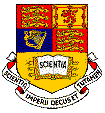
| Information System Engineering, Year 2
Article 1 by
Rajkumar Periannan,
Supervised by Dr T.Field
Paired with Fadi Joseph Fahham
|

 Contents
Contents

Tring!Tring! Tring!Tring!
"Hello! I'm in middle of a lecture."
"I'll have to call you back later."
Everybody in the lecture hall starts bursting into laughter.
This is then typically followed by the lecturer saying
"I wish I had one of those but I can't afford it because I'm just a professor!"
The above is a very typical scene at Imperial College and undoubtedly at other
places too. This goes so much to show that mobile phones are increasingly
becoming a necessity to most people who see it as the most brilliant
invention of the century. What they do not realise is that the mobile phone
only uses one of the possible capabilities(voice transmission) of a cellular network
which is a far more important invention. Besides the commercially available voice transmission for mobile phones, a
cellular network could also be used to transmit data, images, text and
video. A lot of research has been done and is still in progress to realise the
ability to transmit these other form of information via cellular network
commercially available.
This article briefly explains the workings of the cellular network with respect to existing voice transmission.
In addition brief description on how mobile phones work is included.

A cellular network allows cellular subscribers to wander anywhere in the country
and remain connected to the Public Switched Telephone Network(PSTN) via their
mobile phones. A cellular network has a hierarchical structure and it is formed by
connecting the major components mentioned below :-
- Mobile phones[1] - main piece of equipment as far as a subscriber is concerned
- Base Station(BS)
- Mobile Switching Centre(MSC)
Base Station(BS)
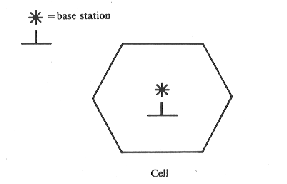
|
The base station serves a cell which could be a few kilometres in
diameter as shown in the diagram on the left.
|
Diagram 1
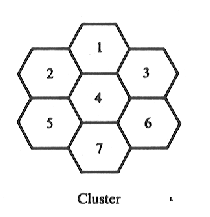
|
The cells when grouped together form a cluster as shown in the diagram on left. |
Diagram 2
All BSs within a cluster are connected to a Mobile Switching Centre(MSC)
using land lines. Each MSC of a cluster is then connected to the MSC of other clusters and a PSTN
main switching centre. This is shown in diagram 3.
The MSC stores information about the subscribers located within
the cluster and is responsible for directing calls to them.
Diagram 3 shows the structure of the network explained above.
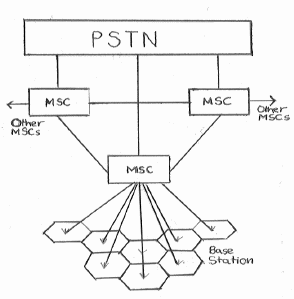
Diagram 3

 Arrangement of cells in a cluster
Arrangement of cells in a cluster
The number of cells per cluster is restricted by the requirement that the
clusters must fit together like jig-saw pieces. The possible cell clusters
are the 4-,7-,12- and 21-cell clusters.
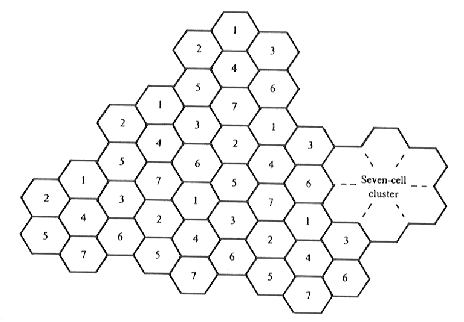
|
The diagram on the left shows a 7-cell cluster which is commonly used in the UK.
|
Diagram 4
 Re-using Frequency
Re-using Frequency
In the UK the bandwidth made available for cellular networks ranges from 890 to
915MHz for base transmission and 935 to 960MHz for mobile transmission. All
transmissions are made via channels. A channel consists of a pair of frequencies,
one for each direction of transmission that is used for full-duplex operation.
In the UK at 1992, the cellular networks had in total 1000 channels(300 allocated to Cellnet and
another 300 allocated to Vodaphone, leaving 400 in reserve for pan-European system
-GSM[2]). This would suggest that fewer than 600 subscribers could access the system
simultaneously when in fact the number of subscribers is in the range of millions.
Research undertaken by Bell Labs has found a solution which involves re-using
the same channel frequency in many different clusters. The cells in these
different clusters using the same channel frequency must be separated far enough so
that co-channel interference[3] would not occur.
 Cell : Shape and Size
Cell : Shape and Size
Shapes
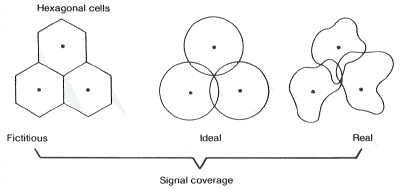
Diagram 5
Hexagonal shaped cells[4] shown in diagram 5 are artificial and cannot be generated in the real world.
However this shape is chosen to simplify planning and design of a cellular system as hexagons fit
together without any overlap or gap in between them.Another advantage of using hexagons is that it
approaches a circular shape which is the ideal power coverage area. The real cell shape
is as shown above and it's shape will keep changing due to prevailing conditions.
Size
The size of the cell largely depends on the area in which the cell is located.
Generally, rural areas have less subscribers compared to urban areas.
So in an urban area more channels are needed to accommodate the larger number of
subscribers. If each cell in a given rural and urban area had fixed number of channels,
the cell size in the urban area would have to be smaller to allow more channels
in the given area. Reducing the cell size would result in cells, using similar channel
frequency, to be located closer to each other. Therefore reducing the size too much
would cause an increase in co-channel interference.
Size of the cell can be varied by varying the power and sensitivity of the base station.
An alternative way to change the size of the cell is to split the cell.[5]
This involves reducing the radius of a cell by half and splitting an old
cell into four small cells as shown below.
Diagram 6
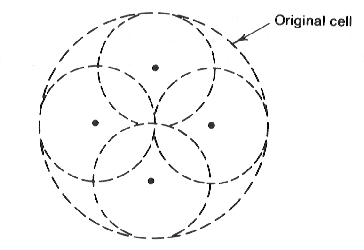

In order to allow mobility to a subscriber
- the cellular network has to have the ability to track the subscriber down when a call is made to him/her.
- allow the subscriber to make calls while he/she is not in his/her home market.
Tracking down is only possible if
- the system maintains information about the location of the subscriber's mobile phone
- the mobile phone knows the appropriate channels to await signals from the system.
In order for both the cellular system and the mobile phone to have these required
knowledge, there are two main procedures to follow when a mobile phone is turned on.
They are :-
 Searching for channels
Searching for channels
There are two channels that are searched by the mobile phone
| Strong Dedicated Control Channel(DCC) |
a channel used for the transmission of digital control information from a base station to the mobile phone or vice versa. |
| Strong Paging Channel |
a channel used by the MSC for seeking the mobile phone when a call made to it. |
This procedure enables the mobile phone to identify the correct channels to wait signals from
the system(eg-when a call is made to the owner of the mobile phone).
 Register to the NEAREST Base Station
Register to the NEAREST Base Station
The mobile phone registers by sending
| Mobile Identification Number(MIN) |
the telephone number of the cellular instrument assigned to the subscriber |
| Electronic Serial Number (ESN) |
this is assigned to the mobile phone by the manufacturer |
The picture below illustrates this graphically
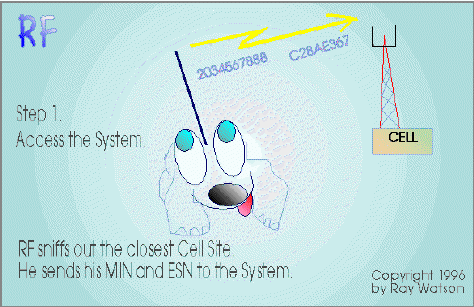
The MSN and ESN are used by the MSC for access validation. This involves
checking with the information stored in the home market of the subscriber.
The second picture below shows this graphically
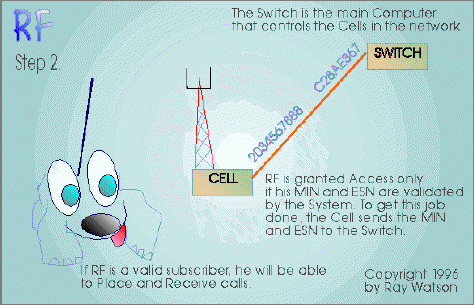
Information about the mobile telephone and it's current position is stored in the Mobile
Switching Centre(MSC).
Both the information stored in the MSC and the paging channel is used by the MSC to direct any
arriving call to the appropriate subscriber.
When the subscriber makes calls, he/she is allowed to be anywhere within the network
as this involves the mobile phone accessing the base station - which could be located
in any of the cells throughout the network.

During a call, the base station would monitor the signal level from the mobile
phone. When the mobile phone is moved into a new cell, the signal level
will fall to a critical value causing the base station to inform the MSC
about this event. The MSC would instruct all the surrounding base stations to
measure the mobile phone's signal level and transfer control to the base station
receiving the strongest signal level. This is known as hand-over and occurs
within 400ms, so the subscribers are hardly aware of a break.
Now registration is done again with the new BS.
Location information stored in the MSC about this mobile telephone is updated.
If the mobile telephone is moved into a cell belonging to a different cluster
it would also have to register with the new MSC.

The usage of cellular network is becoming increasingly popular and more diversified.
As pointed out earlier, mobile phones are extremely common today. In the near future
or even tommorow there would be more devices that uses the cellular network. Currently the
police force in the USA use mobile computers to check license numbers. Who knows, in the
future we might be carrying a hand held device that displays the contents of newspapers and
magazines. All these new invention would require the existing cellular network to be improved.
One of the most important improvement is to create a single global standard for cellular
network to transmit all forms of information. This would allow information to be transmitted
throughout the world and eventually make the world smaller and more united.

| PSTN |
Public Switched Telephone Network |
| MSC |
Mobile Switching Centre |
| BS |
Base Station |
| GSM |
Global System for Mobile communication |
| DCC |
Dedicated Control Channel |
| MIN |
Mobile Identification Number |
| ESN |
Electronic Serial Number |


| Type: | 
| Usefuleness: |


| Readability: |



|

| Type: | 
| Usefuleness: |




| Readability: |




|

| 3.
| Title:
| Mobile Cellular Telecommunications - Analog and Digital Systems | |
| | Author(s):
| Lee W.C.Y. | |
| | Source:
| 2nd Edition, McGraw-Hill, Inc. | |
| |
| Chapter 6, pg 189.Gives a brief explanation about co-channel interference. | |
| Type: | 
| Usefulness: |



| Readability: |



|

| 4.
| Title:
| Mobile Cellular Telecommunications - Analog and Digital Systems | |
| | Author(s):
| Lee W.C.Y. | |
| | Source:
| 2nd Edition, McGraw-Hill, Inc. | |
| |
| Chapter 1, pg 27.Gives concise description about shapes of cells.
| |
| Type: | 
| Usefulness: |




| Readability: |



|

| 5.
| Title:
| Mobile Cellular Telecommunications - Analog and Digital Systems | |
| | Author(s):
| Lee W.C.Y. | |
| | Source:
| 2nd Edition, McGraw-Hill, Inc. | |
| |
| Chapter 10, pg 325.Gives detailed explanation about cell splitting. | |
| Type: | 
| Usefulness: |



| Readability: |



|

 Existing Technology of Cellular Networks-Mobile Phones
Existing Technology of Cellular Networks-Mobile Phones

 Existing Technology of Cellular Networks-Mobile Phones
Existing Technology of Cellular Networks-Mobile Phones




 Contents
Contents








 Introduction
Introduction
 What is a Cellular Network?
What is a Cellular Network?



 Cells and Clusters
Cells and Clusters Arrangement of cells in a cluster
Arrangement of cells in a cluster
 Re-using Frequency
Re-using Frequency Cell : Shape and Size
Cell : Shape and Size


 Allowing Mobility of Subscriber
Allowing Mobility of Subscriber Searching for channels
Searching for channels Register to the NEAREST Base Station
Register to the NEAREST Base Station


 Moving the mobile phone from one cell to another
Moving the mobile phone from one cell to another
 The Future........
The Future........
 Reference
Reference Contents
Contents




































